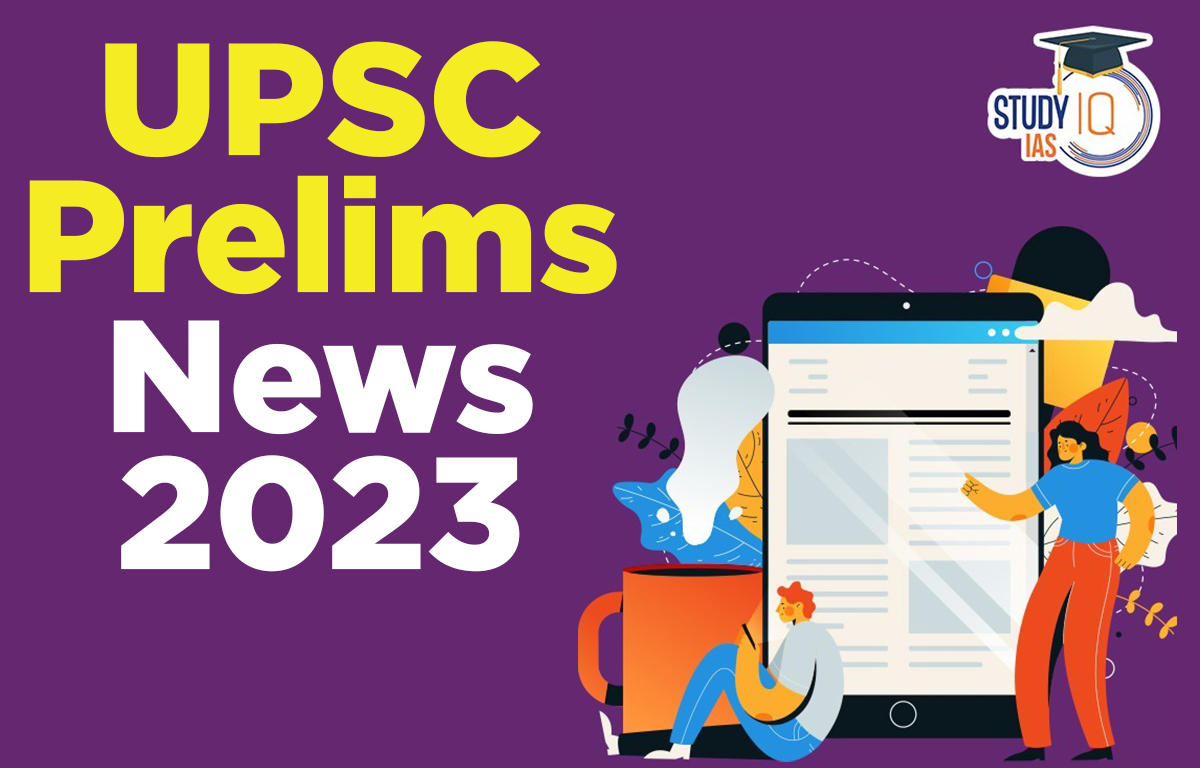UPSC Prelims News of 10 March 2023
Catch the Rain Campaign
Context: President of India will launch the ‘Catch the Rain-2023’ campaign shortly.
More on the News:
- The initiative will be part of efforts to turn conservation of water into a mass campaign in the run-up to the monsoon season.
- Theme: ‘Source Sustainability for Drinking Water’
- The significant role that water plays in the empowerment of women has been acknowledged through the campaign.
- Other event: The President will also confer 18 Awards under Swachh Bharat Mission-Grameen, Jal Jeevan Mission and National Water Mission under various categories and release a collection of case stories titled ‘Swachh Sujal Shakti Ki Abhivyakti’.
Salt Flats
Context: In a new study, researchers from Austria, Germany, and the U.K. have come with an explanation as to why the salt on the surface of salt flats forms ridges that join together in a patchwork of pentagons and hexagons.
About Salt Flats:
- A salt flat is a natural landscape in which a large area of flat land is covered by salt.
- It forms from a natural water body whose recharge rate is lower than the evaporation rate.
- They reflect sunlight strongly and thus appear bright.
- The underlying soil is highly saline: even if the water table is shallow, the groundwater is too salty for humans to drink.
- The world’s most well-known salt flat is the Salar de Uyuni in Bolivia. It is the largest in the world of its kind, and also contains more than half of the planet’s lithium reserves.
Mechanism for the Formation of Polygons/Hexagons:
- The surface of a salt flat has a layer of salt that has been deposited over time.
- So just under the surface, the groundwater is highly saline and denser than the groundwater further below.
- The researchers found that if the rate of evaporation is sufficiently high, i.e. if the rate of salt deposition on the surface is sufficiently high, the denser groundwater will sink down and the less-saline, less-dense groundwater will rise to the top. This body of descending and ascending water is called a convection cell.
- Over time, there will be more saline groundwater rising up towards the surface through the convection cells than through other parts of the soil.
- As a result, the salt this water carries will accumulate on the surface, forming the narrow ridges that make up the polygons.
- Formation of polygonal ridges on salt flats can also be influenced by external factors such as wind and precipitation.
- They can dissolve and redistribute the salt on the surface, altering the shape and pattern of the polygons.
Lewis Super Acid
Context: Researchers in Germany have made a unique class of catalysts called Lewis super-acids.
What are Lewis Super Acids?
- Lewis Acid: Named for the chemist, G N Lewis, Lewis super-acids derive from Lewis acids.
- A Lewis acid is any substance, such as a Hydrogen ion (H+) that can accept a pair of non-bonding electrons. In other words, a Lewis acid is an electron-pair acceptor.
- Lewis Base: A Lewis base is any substance, such as the OH- ion, that can donate a pair of non-bonding electrons. A Lewis base is therefore an electron-pair donor.
- Features:
- Chemical Reactions: As Lewis acids add electron pairs, they are often used to speed up chemical reactions.
- Strong: Lewis super acids are stronger than antimony pentafluoride which is the strongest Lewis acid and can break even the toughest bonds.
- Hard to Manufacture: Breaking strong, chemical bonds require highly reactive substances. As they are so reactive, they are hard to manufacture.
Sagar Mala Project
Context: Recently, 7 Floating Jetties were sanctioned under Sagarmala Program in Karnataka.
About Floating Jetties
- Floating jetties aims to promote and develop a unique and innovative concept of floating jetties which is an alternate solution to India’s over-crowded small harbours used for fishing and tourism related activities.
- The floating jetties have multiple applications including marinas, minor harbours, fishing harbours, fish landing centres and waterdromes.
- These have several advantages over traditional jetties including being environment friendly, having a longer shelf life and being easily re-configurable.
About Sagarmala Programme
- It is the flagship programme of the Ministry of Shipping to promote port-led development in the country through harnessing India’s 7,500 km long coastline, 14,500 km of potentially navigable waterways and strategic location on key international maritime trade routes.
- Vision: To reduce logistics cost for EXIM and domestic trade with minimal infrastructure investment.
- Sagarmala could boost India’s merchandise exports to USD 110 billion by 2025 and create an estimated 10 million new jobs (four million in direct employment).
- Component of Sagarmala Program

“Samarth” (Scheme for Capacity Building in Textiles Sector)
Context: “Samarth” Scheme of Ministry of Textiles will be operational till March 2024.
About Samarth:
- Samarth is a demand driven and placement-oriented umbrella skilling programme of Ministry of Textiles.
- The implementation period of the scheme is up to March 2024.
- The scheme was formulated under the broad skilling policy framework adopted by Ministry of Skill Development & Entrepreneurship.
Aims & Objectives:
- Samarth aims to incentivize and supplement the efforts of the industry in creating jobs in the organized textile and related sectors, covering the entire value chain of textiles, excluding Spinning and Weaving.
- The training programme and course curriculum have been rationalized keeping in view the technological and market demand of the domestic and international economies.
- In addition to the entry level skilling, a special provision for upskilling/ re-skilling programme has also been operationalized under the scheme towards improving the productivity of the existing workers in Apparel & Garmenting segments.
- Samarth also caters to the upskilling/re-skilling requirement of traditional textile sector such as handloom, handicraft, silk, and jute.
Implementation:
- The scheme is implemented through Implementing Partners (IPs) comprising of Textile Industry/ Industry Associations, State government agencies and Sectoral Organizations of Ministry of Textiles like DC/ Handloom, DC/Handicrafts and Central Silk Board.
Advanced Features
- Samarth has been formulated with advanced features such as Aadhaar Enabled Biometric Attendance System (AEBAS), Training of Trainers (ToT), CCTV recording of training programme, dedicated call centre with helpline number, mobile app, Web based Management Information System (MIS), on-line monitoring of the training process etc.
- Furthermore, a total of 184 courses aligned with National Skill Qualification Framework (NSQF) have been adopted under the scheme across various textile segments
Additional Information
- The Ministry has partnered with 116 Textile Industries / Industry Associations, 12 Central / State Government Agencies and 3 Sectoral Organizations of Ministry for undertaking training programmes under Samarth.
- The scheme has been penetrated across 28 States and 6 Union territories of the country and caters to all sections of the society including SC, ST and other marginalized categories.
- More than 85% of the beneficiaries trained so far under the scheme are women.
- More than 70% of the beneficiaries trained in organized sector courses has been provided placement.
Degrowth Communism
Context: Economic growth is fuelling climate change — a new book proposes ‘degrowth communism’ as the solution.
About Degrowth communism:
- Degrowth is a democratically planned effort to downscale levels of production and consumption in order to lighten environmental pressures.
- Degrowth communism could halt the escalating climate emergency.
- Degrowth could act as an emergency brake on vicious cycle, by “terminating the ceaseless exploitation of humanity and the robbery of nature”.

T Bills
Context: T-bill yields have been observed to be continuously in surge, at the same level as 10-year bond.
About T Bills:
- T-bills are the instruments for raising fund by the government for the short-term up to a year.
- Currently they are issued in three maturities: 91-day, 182-day and 364-day (earlier 14-day bill was also issued).
- These bills are issued by the Central government only and interest rate is determined by the market forces.
- Treasury bills are zero coupon securities and pay no interest. Instead, they are issued at a discount and redeemed at the face value at maturity.
- For example, a Rs 100 treasury bill can be availed of at Rs 90, but the buyer is paid Rs 100 on the maturity date.
- They are issued via auctions conducted by the Reserve Bank of India (RBI) at regular intervals.
- Individuals, trusts, institutions, and banks can purchase T-Bills.
- When there is liquidity crisis than the yield is higher on the T-bills.
- It is considered a very safe financial instrument for zero-risk weightage attached to it.
- Banks give treasury bills to the RBI to get money under repo. Similarly, they can also keep it to fulfil their Statutory Liquid Ratio (SLR) requirements.
- T-bills are available for a minimum amount of Rs.25,000 and in multiples of Rs. 25,000.
K Shaped Recovery
Context: The GDP growth for India in its third quarter came down drastically compared to its previous quarter, which economists are describing as a ‘K-shaped recovery’.
About K-Shaped Recovery
- A K-shaped recovery occurs when, following a recession, different parts of the economy recover at different rates, times, or magnitudes.
- This contrasts with an even, uniform recovery across sectors, industries, or groups of people.
- It causes such changes in the structure of the economy or the broader society as economic outcomes and relations are fundamentally changed before and after the recession.
- It is called K-shaped, because the path of different parts of the economy when charted together may diverge, resembling the two arms of the Roman letter “K.”
Other forms of Economic Recovery:
- V-Shaped: It is a rapid and sudden improvement in an economy that follows a rapid and severe fall. This usually happens following a one-time shock to the economy.
- U-Shaped: The economic damage in this type lasts for a longer amount of time before returning to the baseline level of growth.
- L-shaped: In this form, the economy rebounds to some extent from a sharp dip, but growth fails to return to pre-crisis levels, if at all. It is followed by a period of economic stagnation.
- W-shaped: In this type, the economy experiences a rapid collapse, followed by a small and temporary recovery, and then another decline. It is also known as a double-dip recession.


 UPSC Prelims News 20 March 2023
UPSC Prelims News 20 March 2023
 UPSC Prelims News 17 March 2023
UPSC Prelims News 17 March 2023

















